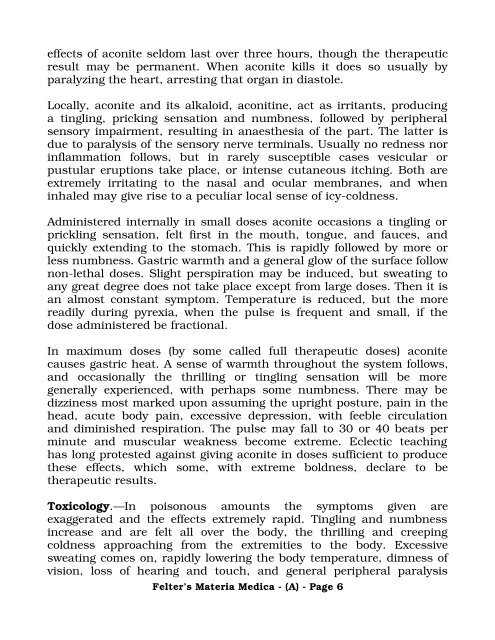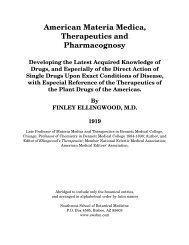Individual Drugs. ABIES (Tsuga canadensis). - Southwest School of ...
Individual Drugs. ABIES (Tsuga canadensis). - Southwest School of ...
Individual Drugs. ABIES (Tsuga canadensis). - Southwest School of ...
You also want an ePaper? Increase the reach of your titles
YUMPU automatically turns print PDFs into web optimized ePapers that Google loves.
effects <strong>of</strong> aconite seldom last over three hours, though the therapeutic<br />
result may be permanent. When aconite kills it does so usually by<br />
paralyzing the heart, arresting that organ in diastole.<br />
Locally, aconite and its alkaloid, aconitine, act as irritants, producing<br />
a tingling, pricking sensation and numbness, followed by peripheral<br />
sensory impairment, resulting in anaesthesia <strong>of</strong> the part. The latter is<br />
due to paralysis <strong>of</strong> the sensory nerve terminals. Usually no redness nor<br />
inflammation follows, but in rarely susceptible cases vesicular or<br />
pustular eruptions take place, or intense cutaneous itching. Both are<br />
extremely irritating to the nasal and ocular membranes, and when<br />
inhaled may give rise to a peculiar local sense <strong>of</strong> icy-coldness.<br />
Administered internally in small doses aconite occasions a tingling or<br />
prickling sensation, felt first in the mouth, tongue, and fauces, and<br />
quickly extending to the stomach. This is rapidly followed by more or<br />
less numbness. Gastric warmth and a general glow <strong>of</strong> the surface follow<br />
non-lethal doses. Slight perspiration may be induced, but sweating to<br />
any great degree does not take place except from large doses. Then it is<br />
an almost constant symptom. Temperature is reduced, but the more<br />
readily during pyrexia, when the pulse is frequent and small, if the<br />
dose administered be fractional.<br />
In maximum doses (by some called full therapeutic doses) aconite<br />
causes gastric heat. A sense <strong>of</strong> warmth throughout the system follows,<br />
and occasionally the thrilling or tingling sensation will be more<br />
generally experienced, with perhaps some numbness. There may be<br />
dizziness most marked upon assuming the upright posture, pain in the<br />
head, acute body pain, excessive depression, with feeble circulation<br />
and diminished respiration. The pulse may fall to 30 or 40 beats per<br />
minute and muscular weakness become extreme. Eclectic teaching<br />
has long protested against giving aconite in doses sufficient to produce<br />
these effects, which some, with extreme boldness, declare to be<br />
therapeutic results.<br />
Toxicology.—In poisonous amounts the symptoms given are<br />
exaggerated and the effects extremely rapid. Tingling and numbness<br />
increase and are felt all over the body, the thrilling and creeping<br />
coldness approaching from the extremities to the body. Excessive<br />
sweating comes on, rapidly lowering the body temperature, dimness <strong>of</strong><br />
vision, loss <strong>of</strong> hearing and touch, and general peripheral paralysis<br />
Felter’s Materia Medica - (A) - Page 6
















